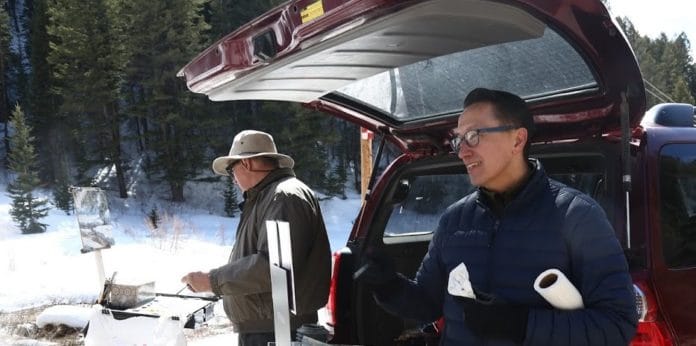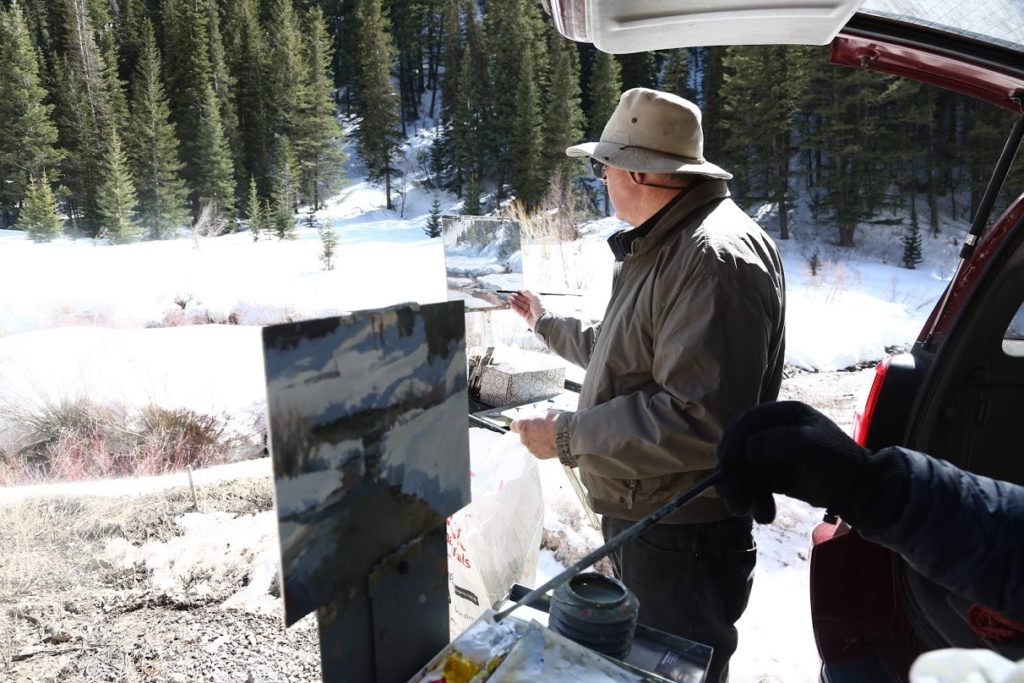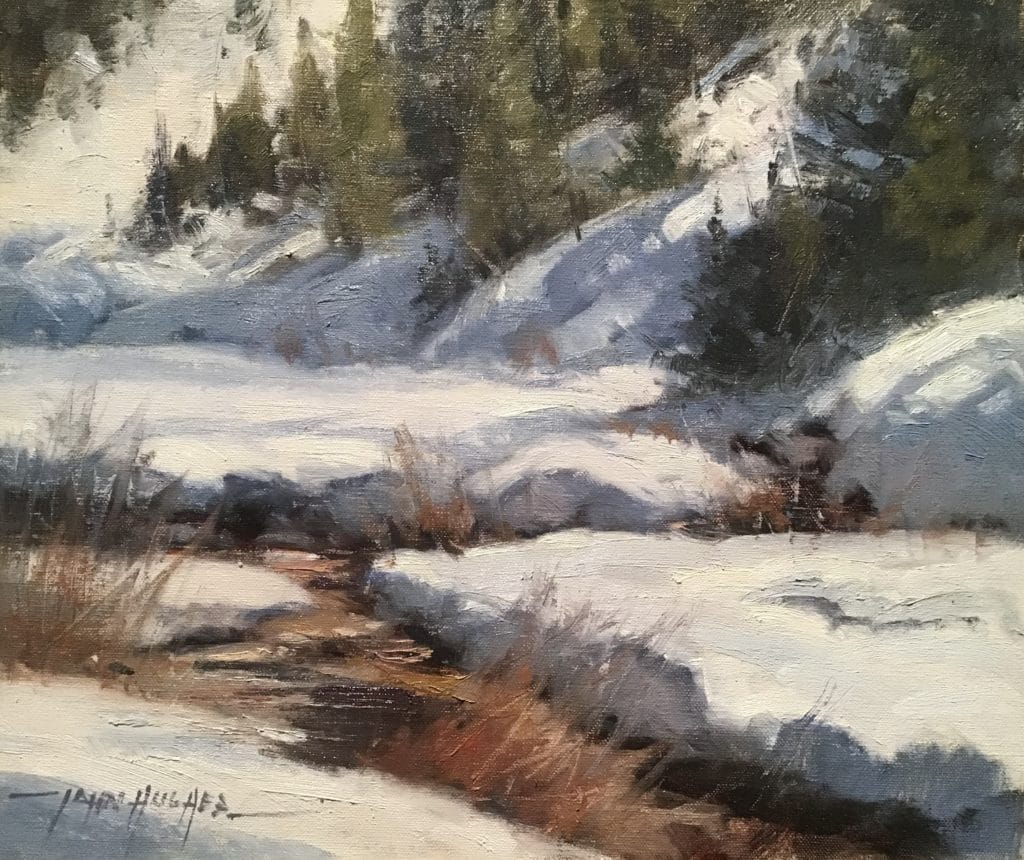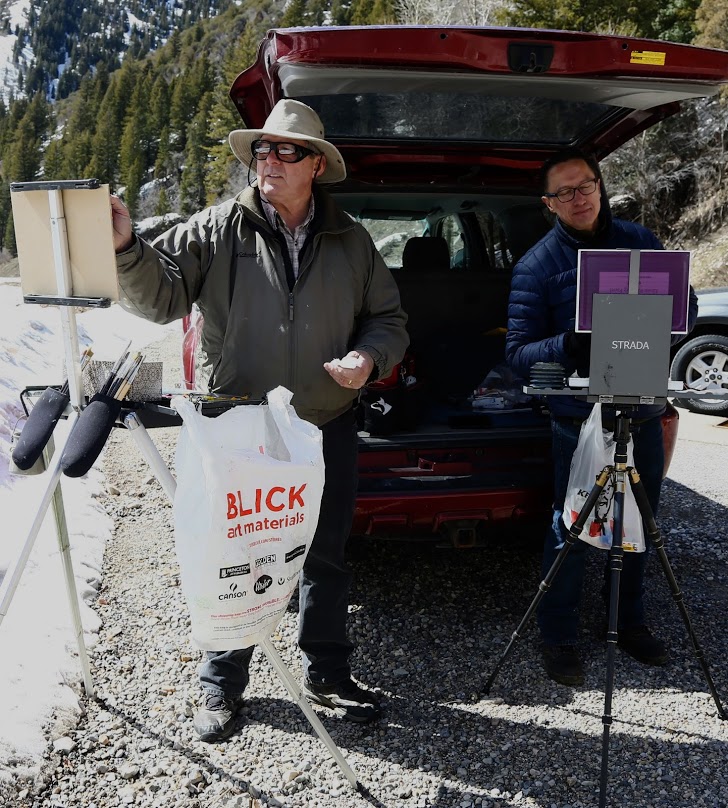
It may seem like a strange thing to be writing about painting snow scenes, just as we’re getting into the warm weather. But truth be known, some of my best snow painting experiences happened on warm sunny days, high in the Wasatch Mountains in June, and sometimes even into July! These are special moments, to be sure, and a delight to be working on a bright sunny day on a mountain trail while wearing a t-shirt.
Snow scenes can be fascinating subjects, with natural design elements of lights, mid-tones, and darks. Additionally, snow has a special appeal factor that conjures up the kinds of feelings associated with peace, fun, Christmas, and even “Stopping by Woods on a Snowy Evening” by Robert Frost. They also have the added benefit of being associated with skiing and other winter sports, which creates excitement for the viewer as well.
Having grown up in the Northeast I have always been attracted to paintings that have snow as an element of design, whether a complete blanketing of snow, or patchy areas in a scene, which create interesting light and dark patterns.

Is Snow White?
When attempting to paint snow for the first time, a beginner will usually go directly for the white paint, rendering what they think about snow, rather than what is actually there to be observed. That’s why when rendering the fluffy stuff, even on a bright sunny day, the main body of snow should be subdued, so the highlights have a chance to register. Painting that part darker than the value of white by a couple of steps will usually solve this relationship problem, and give the overall sensation of what you are after.
The next time you’re out in a field of snow on a bright sunny day, you will immediately notice how blinding the glare can be. Note also that even with all of this glare, nature still leaves room for highlights on this blinding mass. As an experiment, make a snowball and throw it out in front of you a few feet away and notice the highlights as well as the darker shadows created by the indentation of the snowball. Once you see this, you can then begin to express yourself artistically, while adding believability to your snow scenes.
Along with value, there are also the expressive nuances the artist can bring to the painting with color. Going back to the beginner trying to use white paint, it’s important to look around and make an earnest study of the subject in order to see the variations of color in a snow scene. It really comes down to observation. The color can vary, depending on several factors, such as how dense or crystallized the snow is on a particular day and the quality of the light.
I hate to set down formulas, so take this explanation for what it’s worth in a general sense. The typical look of a snow field on a bright sunny day, is a light gray with hints of warm and cool temperatures on the main mass. It often presents as a violet gray with the warmer tones dominating. The reason for this is that the warmth coming from the stronger power of the sun is partly cancelled out by the weaker power, which emanates from the dome of the blue sky. However, the more powerful light source of the sun wins out, and exerts its temperature ever so slightly.
This understanding will help the beginner to realize the futility of using white paint alone as a solution in depicting snow. Subtle color and value differences are not only present in the sunlit part of the snow, but the shadows as well, and even more pronounced there! In these shadows, the artist will notice warm reflected light from the surrounding landscape, as well as the ever present influence of the blue sky.
A word of caution though, due to the over use of photography, many inexperienced painters of snow use too much blue in the shadows as well as too much pure white in the sunlit areas. It’s easy to misjudge these colors from photo reference, and I think that many of us have done that when we were first starting out. A touch of red and a cool yellow, such as lemon yellow, will go a long way in knocking the edge off of that neon blue.
Ultimately though, errors are what we artists learn from, and the best advice I can give is to go out in nature and study from life, relying on pure observation as a cure for any faulty assumptions.

On a recent trip into one of our local canyons, before all of this virus stuff was in full swing, I went out one day with my good buddy and fellow painter, John Poon, to capture a bit of the snowy landscape. It was a real bright day, which usually presents a few extra challenges besides the winter cold. The main challenge in this type of situation is glare, which hits your eyes from all angles and can often make your painting experience very difficult. This same situation also exists when attempting to paint a coastal beach scene on a sunny day. The sunlight bouncing off the sand can, in many ways, mimic the challenges faced by artists painting snow.
My unusual way of dealing with all of this glare is a pair of fisherman’s fit over sunglasses, with the lenses popped out! These sunglasses were originally meant to fit over regular glasses and have the added benefit of shielding light which hits you from the top, bottom and sides. It’s amazing how, just shielding the area around your eyes, will take care of a large portion of your glare problem. That and a wide brimmed hat are just what the doctor ordered! I have to say though, when you go out painting with this ensemble, you are not there to make a fashion statement. As a matter of fact you will most likely appear to be a real goofball, as evidenced by the accompanying photos:
For you lady painters out there, it can also have the added benefit of warding off any unwelcome attention by a guy named “Bubba”, who drives an old pickup truck, and is out looking to hassle unsuspecting plein air gals! Sorry in advance to all the Bubbas of the world, no offense intended!

Although John Poon wasn’t wearing his pair that day, he swears by another solution in the form of Maui Jim’s sunglasses, which don’t have the lenses popped out. I was surprised to hear this, but was all ears. I only used a pair of real sunglasses once while painting in a snow field years ago, and that’s because I was desperate. I had to turn the painting into the direct light of the sun to even see what I was doing though, but it was better than all of the glare, before I discovered fit-overs. John says that Maui Jim’s are like no other sunglasses and I’m curious about them for this purpose. There are two types, one cool and one warm; he says to buy the warm version. They also come with a hefty price tag, but if it does the job, it may be something worth considering.
Until next time,
John Hughes
Related > Learn how to paint poetic landscapes with John MacDonald in this Streamline Premium Art Video
Upcoming travel and art events with Streamline Publishing:
> Click here to subscribe to the free newsletter, Plein Air Today
> And click here to subscribe to PleinAir Magazine so you never miss an issue!
> NEW! GET YOUR WORK FEATURED IN PLEIN AIR TODAY




Great article, full of wisdom and tips from the 2 Johns, thank you both. Best advice ever, to go out in nature and study from life. Great paintings, too!
Rick, So true, getting out there is the best part. Thanks for your comment!
Very sound advice from a reliable source! Really great tips thank you. You a professional!! 😃
Well, thank you J, I appreciate that!🙂